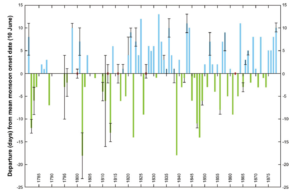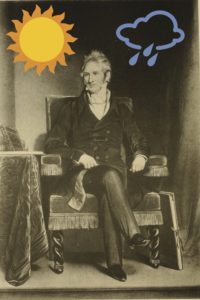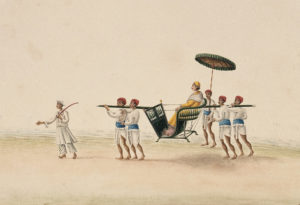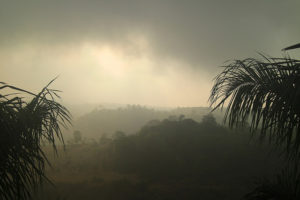Weather and climate shape cultures and the lives of people everywhere. People have been watching and recording the weather for centuries. Weather observations have been recorded in many different shapes and forms. Modern weather observations most often come in structured data from weather stations on the ground, ships at sea, planes in the sky and satellites far above the Earth’s surface. These observations are vital to run and verify our ever-advancing weather and climate models. Unfortunately, in many parts of the world, the modern observations do not extend far back in time. But if people have been watching the weather for centuries, they must have told someone, or maybe drawn it, painted it or written it down. Maybe we could access these sources to help us better understand the changing climate. And if this weather information was recorded in different ways then maybe it can tell us something about culture too. To find this information, we need someone who knows where to look. We need a climate detective.
Today, this is where George Adamson and his colleagues come in. George is a Geography lecturer at King’s College London, and is officially known as a Historical Climatologist. A historical climatologist investigates historical documents for clues about what climate and weather was like before, and also how society interacted with the climate. These documents include old newspaper articles, weather diaries, personal correspondence, government records and ship logs [1]. Such documents need to be carefully interpreted, and historical climatologists need to call upon their skills in in both history and climatology [1]. They normally apply their skills to a single region at a time, and usually a single parameter, like rainfall, temperature, and tropical cyclone occurrence for example.
In George Adamson’s study, he spent two years searching for stories about the monsoon onset in Bombay. George spent most of his time at the British Library, but also at archives in India and the USA [2]. He read thousands of pages and recorded everything relating to weather and climate. For example, the local newspaper in Bombay published weather observations and editorials about the monsoon and local climate. And George read it all. He ended up with over 3000 quotes ranging from a couple of words (and numbers) to substantial essays [3]. But how would he use all these quotes?

Figure 1: The monsoon onset dates for Bombay back to 1781 as a result of George Adamson’s investigations [2].
[For 1796] the one piece of writing that said there was no monsoon, was a week and a half before the next piece that said the monsoon had started. It can be very ambiguous, so I just had to choose the middle point between the two sets of data [4]
Some onset dates were obviously much harder to nail down than others. Also, some sources were more reliable than others. George used different criteria to determine the reliability of the sources. From George’s judgments on the information’s ambiguity and reliability, he applied error bars around the most likely onset date each year. You can see from Figure 1 that some dates were more problematic than others. Despite the challenges he faced, George successfully compiled a time series of monsoon onsets extending right back to 1781 (Figure 1).

Figure 2: Mountstuart Elphinstone – Governor of Bombay (image source).
The documents not only informed about the monsoon onset in the 1700 and 1800’s, they also contained a wealth of other stories. These stories gave insight into the life of the Bombay aristocracy at the time, and some dark overarching ideas about the tropical climate. For example, George studied the diaries of the colonial Governor of Bombay, Mountstuart Elphinstone (Figure 2), and the Chief Justice’s wife, Lucretia West [5]. Both of them were in the top level of British aristocracy in Bombay in the 1820’s and their stories clearly reflected this. Tropical climate made their lives challenging and influenced the way they felt about the local people. In fact, the colonial powers truly believed that the hot tropical climate made the native populations inferior to the Europeans. The Europeans therefore risked “degenerating” whilst working in the Tropics. In Bombay, Mountstuart and Lucretia both described the climate as detrimental to their health. It affected Mountstuart’s work:
The southerly winds famous among Bombay people for bringing drowsiness & prickly heat, have been blowing for this fortnight among many other effects of them I have within these 3 or 4 days felt a slowness of understanding [5]
Lucretia did not have to work directly but she mentioned the local climate often and said that she could only exercise at certain times of day. It’s worth mentioning that this exercise was likely being carried around in a sedan chair or a litter (Figure 3). Problems with the tropical climate were not just considered problematic in day-to-day routines. The climate had much wider implications for the ruling colonial powers in India. In fact a whole discourse emerged known as “acclimatization”, which considered how colonial people could adapt to the tropical “torrid zone”. At that time, the colonial powers believed that they were superior to the local people in the Tropics. They also believed that the tropical climate could induce apathy. They decided that the climate was the reason the local people were lazier, weaker, more ugly and less intelligent than the ruling Europeans. This sounds rightly ridiculous today, but at that time, the Europeans believed that acclimatization meant that they could stay in control.

Figure 3: A sedan chair or litter: the type of transport used by the colonial aristocracy in Bombay in order to avoid the burdens of the local climate (image source).
The colonial immigrants used different solutions to acclimatize and remain “superior”. For example, some people put “tatties” (damp vegetation) across their windows to keep their homes cool. One of the most effective solutions was to move to a place where the climate was more appropriate. This was where the colonial Hill Stations (Figure 4) of India came into play. The aristocrats would travel to the newly founded Hill Stations high up in the Indian mountains. The effect seemed dramatic. Lucretia described that the climate at the hill stations would help her retain her “Englishness”, and in fact even regain her “English looks” [5]. The stories that George came across in the
diaries illustrate how weather and climate infiltrated colonial discourse. These fascinating stories (with dark and prejudice connotations) illustrate how climate interlinked with issues like health, race, environment and ethics.
But the stories also gave important clues about how the weather itself was behaving, and when the monsoon started each year. Climate scientists can incorporate this new information into model verifications to better understand past climate variability. This is possible thanks to the efforts of George Adamson and his climate-detective colleagues. Historical climatology has the powerful potential to discover important information about the past climate, and also how the climate can influence politics and perception.

Figure 4: Photo of the Indian hill station, Khandala (image source).
References:
- Nash DJ, Adamson GCD. Recent advances in the historical climatology of the tropics and subtropics. Bulletin of the American Meteorological Society. 2014;95(1):131-46.
- Adamson GCD, Nash DJ. Documentary reconstruction of monsoon rainfall variability over western India, 1781–1860. Climate dynamics. 2014;42(3-4):749-69.
- Adamson GCD, Nash DJ. Long-term variability in the date of monsoon onset over western India. Climate dynamics. 2013;40(11-12):2589-603.
- Adamson G. Personal communication. 2014.
- Adamson GCD. ‘The languor of the hot weather’: everyday perspectives on weather and climate in colonial Bombay, 1819–1828. Journal of Historical Geography. 2012;38(2):143-54.







